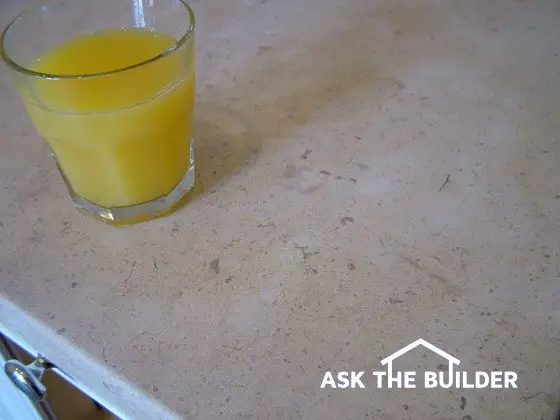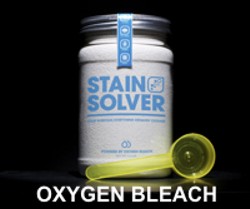Limestone Countertops

This limestone countertop is gorgeous. You can see the fossils that helped create the stone! PHOTO CREDIT: Tim Carter
DEAR TIM: Limestone countertops are on my radar for a new kitchen I’m planning. My contractor is trying to dissuade me saying I’ll have problems with a limestone countertop. He says that common foods will stain it, and vinegar or other acidic foods will erode it. The stone supplier says that the limestone counter will perform well over time. How hard are they to install? Can a skilled homeowner handle the installation of the stone tops? Can you share any tips? Diane S., Dousman, WI
DEAR DIANE: Limestone counter tops rank right at the top of my take-your-breath-away countertop contest. If you go to a stone fabricator’s showroom and see a limestone countertop sample that has thousands of fossils in it, you’ll be mesmerized for sure. I love granite tops because of the deep color and some of the magnificent crystals, but the buff shades of limestone mixed with the fossils create a classic look that will generate unending compliments from all that see the stone in your new kitchen.
If you go online, you’ll see all sorts of discussions about limestone counters. Some people rave about them and others rail against them saying they’ll stain, erode, pit, etc. I remember seeing similar comments about granite tops, and now wonder if some of the comments you see aren’t written by competitors who might be spreading false information. For example, the granite tops in my kitchen have never had an issue with staining, even though they are a light granite which supposedly is very susceptible to staining.
You need to know that natural stone, and limestone is one, by their very nature are porous to a degree. But not all limestone countertops are equally porous. Some limestone formations are extremely dense, and as such, liquids have a tough time penetrating into these solid stones. What’s more, there are special sealers and impregnators you can coat the limestone with to minimize staining. It’s wise to reapply these sealers periodically. The stone fabricator that makes your limestone tops will almost always recommend a high-quality sealer.
Even if the limestone gets stained, you can almost always remove the stain by using oxygen bleach. Oxygen bleach will not react chemically with the limestone, but it absolutely will break apart the organic compounds that make up all foods and liquids that you commonly cook with. Red wine, beet juice, grape juice and hundreds of other food stains can be easily removed from limestone, or any other countertop, using oxygen bleach.
Limestone can be chemically etched with acids. Strong hydrochloric acid will make the limestone fizz causing severe damage to the stone. Building supply houses sell this as muriatic acid. Never get this acid anywhere near a limestone countertop. Vinegar, citric fruit and some other foods like tomatoes are acidic. These mild acids might harm the limestone if allowed to sit on the stone for long periods of time. The best practice is to get the limestone countertops damp before you work with these foods and liquids, and immediately clean up rinsing the top well after you get these acids on the top.
A limestone kitchen counter is not a job I would trust to a homeowner that has no experience. The limestone is very heavy. A square foot of the stone that’s one and one-half-inches thick can weigh nearly 20 pounds. A simple island top can weigh nearly 400 pounds! If you don’t transport and carry the limestone correctly, it can crack.
The cabinets that you set the limestone on need to be perfectly level and in the same plane. The limestone needs to rest solidly on the cabinets with no gaps under the stone. It’s best to install 3/4-inch-thick plywood that’s flush with the top of the cabinet frames so the limestone is completely supported. Without this support, it’s possible the stone could crack if someone sat on the counter or stepped on it to paint a ceiling, change a light bulb or even dance. Stranger things have happened on kitchen counters.
If you’re still on the fence trying to decide who’s right and wrong with respect to durability and staining, try to see if the local stone supplier has a list of past customers. Do your best to find a homeowner that has had a limestone kitchen counter for at least three years. Call them and ask them these two questions: How has it held up? Would they use limestone for kitchen counters again?
It requires great skill to install limestone countertops. Seams between slabs of limestone need to be grouted or filled with special epoxies. To make the seams invisible, you need to tint the fillers to match the surrounding fossils and tones of the limestone. You only get one chance to do it correctly.
If you make a mistake setting the stone tops, you can chip an edge with great ease. You can’t allow the stone to bang against another piece of stone. This means that setting multiple pieces in between two walls can be an enormous challenge. It’s mission critical that you slide the last piece of stone in horizontally. If you try to tilt it into place, you’ll chip an edge as certain as the sun will rise tomorrow.
Column 777

2 Responses to Limestone Countertops